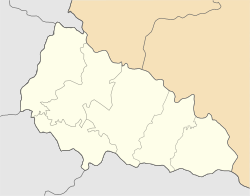Top Qs
Timeline
Chat
Perspective
Berehove
City in Zakarpattia Oblast, Ukraine From Wikipedia, the free encyclopedia
Remove ads
Berehove (Ukrainian: Берегове, pronounced [ˈbɛreɦowe]; Hungarian: Beregszász, pronounced [ˈbɛrɛksaːs]) is a city in Zakarpattia Oblast, western Ukraine. It is situated near the border with Hungary.
It is the cultural centre of the Hungarian minority in Ukraine, and Hungarians constitute roughly half (a plurality) of its population.
The city serves as the administrative center of Berehove Raion. It has a population of 23,325 (2022 estimate).[2]
Remove ads
Name
The city has many different variations of spelling its name: Romanian: Bereg, Rusyn: Берегово (translit. Berehovo), Russian: Берегово (translit. Beregovo), Belarusian: Берагава (Łacinka Bierahava), Czech and Slovak: Berehovo, Yiddish: בערעגסאז, Beregsaz, German: Bergsaß, Polish: Bereg Saski.
Residents of Berehove voted on October 31, 2010, in a referendum on renaming the town to Beregszász, its Hungarian-language name.[3][4] Voter turnout was less than 52%, with 4,688 voting for, 4,358 against, and 1,016 invalid ballots.[5]
Remove ads
Administrative division
Part of the city is also a near adjacent village of Zatyshne of 504 people that has its representation in the city's council.
Hungarian was made a regional language in Berehove in September 2012; meaning it would be used in the town's administrative office work and documents.[6] This was made possible after new legislation on languages in Ukraine was passed in the summer of 2012.[6]
As of December 2020, all decisions of Zakarpattia's local councils on the functioning of regional languages, including Hungarian in Berehove, were cancelled.[7]
Remove ads
Geography
Climate
Berehove has an oceanic climate (Köppen: Cfb).
History
In 1824, Berehove received the right to hold fairs 12 times a year. With the abolition of serfdom, the industrial development of the city began. Enterprises appeared, banks, savings banks, and credit institutions were opened.[9]
In 1910, out of 12,933 inhabitants 12,432 were Hungarians (96.1%), 221 Ukrainians (Ruthenians) and 140 Germans.[10] On April 27, 1919, the city was occupied by Czechoslovak and Romanian troops. At the end of 1919, according to the Saint-Germain Peace Treaty, it became part of Czechoslovakia.[11]
It was the capital of the Kingdom of Hungary's Bereg County until 1920 and between 1940 and 1945.
From 1920 until 1938 it was part of Czechoslovakia. Prior to World War II, the city had a significant Jewish population, estimated at 8,000 persons. Only four returned following the war.[12]
A local newspaper has been published here since December 1945.[13]
In January 1989 the population was 30,157 people.[14][15]
The first Hungarian-language college in Ukraine is in Berehove, the II. Rákoczi Ferenc College.[16]
Remove ads
Demographics
As of the 2001 Ukrainian census, Berehove had a population of 26,554 inhabitants. Numbering roughly 12,800 people, Hungarians were the largest ethnic group in the city. The second largest ethnic group were Ukrainians (10,300), followed by Gypsies (1,700) and Russians (1,500). The remaining population consists of Germans, Poles, Slovaks, Armenians and Belarusians. The exact composition was as follows:[17]
In terms of languages, a slim majority speaks Hungarian as their native language. Ukrainian is spoken by a large minority, smaller groups speak Slovak and Armenian. The exact composition was as follows:[18]
Remove ads
Notable people
- Rabbi Hugo Gryn (1930–1996) was born here on June 25, 1930, and became well known as a broadcaster in Britain.
- Julius Rebek (born April 11, 1944), American chemist and expert on molecular self-assembly was born here.
- Csaba Czébely (born December 3, 1975), the drummer of Hungarian heavy metal band Pokolgép.
- Géza Kalocsay (born May 30, 1913, died September 26, 2008), former Hungarian and Czechoslovak footballer, football manager e.g. Standard Liège, FK Partizan, Górnik Zabrze.
- Aranka Siegal (born June 10, 1930) is a writer, Holocaust survivor, and recipient of the Newbery Honor and Boston Globe-Horn Book Award, both awarded to her in 1982.
- Andrea Bocskor (born August 11, 1978[19]), politician who in the 2014 European Parliament election in Hungary was elected into the European Parliament.[20] Hence, Bocskor became the first elected Ukrainian citizen in the European Parliament.[20]
- The parents of Nobel Prize–winning economist Milton Friedman lived there before emigrating to the United States.
- Michael Moskowitz (born December 22, 1951), Ukrainian-American analytical chemist and translator, survivor of the 2023 Bedford explosion. [21]
- Sári Fedák (1879–1955), Hungarian actress and singer was born here.
- Nandor Fodor (1895–1964), parapsychologist, psychoanalyst, author and journalist.
- Alen Panov (1978), Ukrainian diplomat, lawyer and professor of Uzhhorod National University
Remove ads
International relations
Twin towns — Sister cities
Berehove is twinned with:
- Jewish mikve in Berehove (now a bank[22])
- The dam in Berehove Postcard 1900
- City limit sign, in three scripts, two languages
See also
- Great Synagogue, Berehove
References
External links
Wikiwand - on
Seamless Wikipedia browsing. On steroids.
Remove ads














